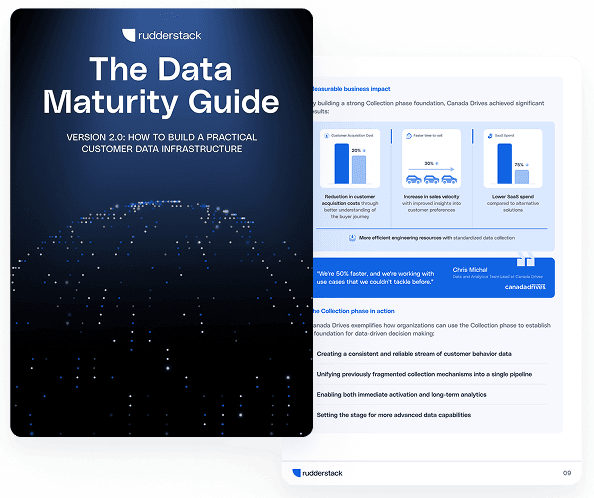What is AI data governance? A guide for data teams

When an AI system makes a decision you can't explain, trust quickly disappears. According to a recent survey, 80% of business leaders consider AI explainability, ethics, or bias a major roadblock to generative AI adoption. What happens behind the scenes matters just as much as the results your models deliver.
If you care about using AI responsibly, you need more than just accurate data. You need clear, practical AI data governance to keep your automations fair, compliant, and under your control.
In this guide, we'll break down the key principles, roles, and practices that define modern AI data governance. You'll learn how to design governance systems that scale with your AI programs while remaining audit-ready and regulation-compliant. We'll also explore how RudderStack supports this mission with real-time monitoring, privacy-first data pipelines, and full control over your customer data stack.
Main takeaways:
- AI data governance extends traditional data governance by addressing the unique risks of machine learning, including bias, explainability, and automation oversight
- An effective governance framework includes data stewardship, ethical guidelines, strict quality standards, and lifecycle monitoring from ingestion to model retirement
- Automation is essential to scale governance practices, enabling real-time validation, data drift detection, and continuous compliance enforcement
- Clear ownership and defined roles across data, engineering, and compliance teams are critical to maintaining accountability throughout the AI lifecycle
- Flexible governance systems are necessary to adapt to evolving regulations and support responsible, future-proof AI development at scale
What is AI data governance?
AI data governance is a framework of policies, processes, and controls that ensure data used in AI systems is high-quality, secure, compliant, and ethically managed throughout its lifecycle. It builds upon traditional data governance by addressing the unique challenges of machine learning and automated decision-making.
The rise of AI adoption has made data governance for AI increasingly critical as organizations face new risks related to bias, privacy, and regulatory compliance. Without proper governance, AI systems can amplify small data issues into significant problems that affect business outcomes and customer trust.
| AI governance focus area | Example implementation |
|---|---|
| Data quality | Schema validation at ingestion using tools like RudderStack |
| Bias prevention | Auditing training datasets for demographic representativeness |
| Privacy & security | Tokenizing PII before feeding data into LLM pipelines |
| Compliance alignment | Mapping AI outputs to GDPR/CCPA consent requirements |
| Lifecycle oversight | Setting drift detection triggers and retraining workflows |
AI data governance helps you maintain control over how your data is collected, processed, and used in AI applications. It ensures that automated systems make fair decisions while complying with regulations like GDPR and CCPA.
AI data governance vs. traditional governance
Traditional data governance establishes frameworks for managing enterprise data assets, primarily focusing on data quality, security, access controls, and regulatory compliance. It treats data as a relatively static resource that needs protection and standardization.
Data governance for AI systems, however, introduces complex requirements that address the dynamic, learning nature of machine learning algorithms and their automated decision-making capabilities.
The fundamental differences emerge from AI's unique characteristics: its ability to continuously learn from new data, make autonomous decisions without human intervention, and potentially amplify biases present in training data.
While traditional governance manages relatively stable data assets with fixed schemas and predefined uses, AI governance must simultaneously monitor both the quality of data inputs and the fairness, accuracy, and explainability of algorithmic outputs. This dual focus requires governance frameworks that can adapt to evolving models, detect drift in both data and model performance, and maintain ethical standards across the entire AI lifecycle.
| Aspect | Traditional governance | AI governance |
|---|---|---|
| Focus | Data quality and access | Bias prevention and explainability |
| Risk management | Data security and compliance | Ethical implications and automation risks |
| Monitoring | Periodic audits | Continuous model performance tracking |
AI in data governance requires you to think beyond static rules. Your governance approach must evolve as models learn and adapt from new data.
Key elements of an AI data governance framework
An effective AI data governance framework consists of four essential elements that work together to ensure responsible AI development.
1. Data stewardship responsibilities
Data stewards play a critical role in AI governance by defining quality standards and documenting data lineage. They establish clear ownership of datasets and create approval workflows for AI use cases.
- Quality standards: Define what constitutes acceptable data for AI training
- Data lineage: Track how data moves and transforms through your systems
- Ownership: Assign responsibility for each dataset used in AI applications
2. Ethical principles and fairness
Ethical guidelines help prevent bias and ensure fair outcomes from AI systems. Regular audits of training data can detect potential discrimination before it affects model outputs.
You need clear processes for identifying and addressing ethical concerns throughout the AI lifecycle. This includes diverse representation in test datasets and documented fairness metrics for model evaluation.
3. Data quality guidelines
AI systems require especially high-quality data to function properly. AI-powered data governance establishes specific quality requirements for training and testing data.
- Completeness: Ensuring datasets contain all necessary attributes
- Accuracy: Verifying data correctness through validation
- Consistency: Maintaining uniform formats across data sources
- Representativeness: Including data that covers all relevant scenarios
4. Lifecycle oversight
Governance must extend across the entire AI data lifecycle, from collection to retirement. This comprehensive oversight ensures compliance, quality standards, and ethical guardrails remain intact at each critical junction.
During collection, validate data sources and consent. In preprocessing, document transformations and quality checks are performed. Throughout model training, track feature selection and bias mitigation efforts. At deployment, implement approval workflows and explainability documentation. While in production, maintain continuous monitoring for drift and performance degradation. Finally, at retirement, execute proper data archiving or deletion protocols following retention policies.
Did you know? By 2027, 60% of organizations will fail to realize the anticipated value of their AI use cases due to incohesive data governance frameworks, according to Gartner. A structured governance strategy is essential to AI success.
Best practices for implementing AI data governance
Putting AI and data governance into practice requires clear processes for compliance, security, automation, and accountability, as recommended in the AI Risk Management Framework developed by NIST.
1. Ensure compliance and privacy
Start with consent management by obtaining and respecting data usage permissions. Implement role-based access controls to limit sensitive data exposure and follow data minimization principles.
Regulatory frameworks like GDPR, CCPA, and HIPAA provide guidelines for handling personal data. Your governance framework should align with these requirements while remaining flexible enough to adapt to new regulations.
Example use case: A fintech company uses RudderStack to automatically enforce GDPR consent flags before routing user data into LLM-powered underwriting models. By filtering and labeling data at the collection layer, they avoid unauthorized data use and maintain audit readiness.
2. Strengthen security with encryption and access controls
Apply encryption to protect sensitive data both at rest and in transit. This prevents unauthorized access while maintaining data utility for AI training.
- At-rest encryption: Protects stored data in databases and file systems
- In-transit encryption: Secures data as it moves between systems
- Field-level protection: Masks or tokenizes sensitive attributes
Implement granular access controls based on user roles and document all data access in audit logs for compliance and security monitoring.Example use case: A healthcare platform tokenizes patient identifiers using field-level hashing before sending them to ML services for diagnostics support. This protects privacy while maintaining the ability to match outputs back to real patients when authorized.
Ready to build a foundation for responsible AI? Request a demo to see how RudderStack can help strengthen your AI data governance framework while maintaining complete control of your customer data.
3. Automate quality assurance and validation
Manual governance processes don't scale with AI workloads. AI-enabled data governance uses automation to maintain quality and compliance at scale.
Implement real-time data validation through schema enforcement at ingestion points. Set up anomaly detection to identify outliers or unexpected values that could affect model performance.
Monitor for data drift by comparing incoming data distributions against established baselines. This helps you identify when retraining is necessary to maintain model accuracy.
Example use case: An e-commerce company uses RudderStack to detect schema changes in product event data before it hits their feature store. If a required field is missing or renamed, they halt model training and trigger a notification to engineering.
4. Establish governance roles and accountability
Effective governance requires clear ownership across the AI lifecycle. Define specific roles such as data stewards, ML engineers, privacy officers, and compliance teams.
Create a governance charter that documents who is responsible for each aspect of data and model management. This prevents ownership gaps that can lead to compliance issues or duplicated efforts.
Example use case: A global media company defines ownership over training datasets, model approval, and compliance reviews using a documented RACI matrix.
5. Define escalation paths for ethical concerns
Create formal procedures for reporting and resolving ethical or compliance issues. Centralized reporting mechanisms make it easy for team members to flag potential problems.
The escalation process should include clear guidelines for severity assessment, review timelines, and resolution tracking. This ensures that concerns receive appropriate attention and documentation.
Example use case: A logistics firm using AI for route optimization defines an internal review board to handle flagged edge cases, like biased recommendations or service prioritization discrepancies, before they impact operations.
6. Incorporate human oversight for high-risk AI
For critical AI applications, implement human-in-the-loop checkpoints at key decision points. This provides an additional layer of review for high-impact or sensitive decisions.
Human oversight is especially important in regulated industries like healthcare, finance, and legal services. It helps catch edge cases that automated systems might miss while providing accountability for AI decisions.
Example use case: A healthcare AI provider requires manual review before deploying any diagnostic model changes to production, especially those involving rare diseases or high false-negative risk.
Factors that undermine effective AI data governance
Even well-designed governance frameworks can fail without proper implementation. Understanding common pitfalls helps you avoid them.
Governance at scale requires automation
Manual governance processes break down as AI workloads grow, especially as global data volumes are projected to reach 180 zettabytes by 2025. Without automation, you'll face inconsistent enforcement, documentation gaps, and delayed issue detection.
Implement automated metadata capture, quality validation, and lineage tracking to maintain visibility as your AI initiatives expand. Embed governance checks in your development pipelines to catch issues early.
Future regulations require flexible systems
Data and AI governance must adapt to rapidly evolving regulations across global jurisdictions. Designing governance frameworks solely for today's compliance landscape creates technical debt that becomes increasingly costly as new AI-specific legislation emerges. Organizations caught flat-footed by regulatory shifts often face implementation bottlenecks and compliance gaps.
Build forward-compatible systems by documenting model impacts through detailed decision records, maintaining comprehensive audit trails with version-controlled lineage tracking, and implementing flexible access controls based on attribute-level permissions rather than rigid role structures.
Establish regulatory horizon scanning as a formal process, with quarterly reviews of emerging AI legislation. This systematic approach prepares you for emerging AI-specific regulations like the EU AI Act, state-level algorithmic accountability laws, and industry-specific frameworks that increasingly demand explainability and fairness demonstrations.
Ownership gaps lead to governance failures
Unclear accountability creates dangerous governance blind spots that derail AI initiatives. Without designated owners, critical tasks fall between organizational cracks; compliance checks get skipped, model documentation remains incomplete, and ethical reviews happen inconsistently. This accountability vacuum often leads to reactive firefighting rather than proactive risk management.
Establish crystal-clear RACI matrices for every aspect of AI governance, from data acquisition to model retirement. Designate specific owners for bias detection, explainability requirements, and regulatory compliance checkpoints.
Cross-functional governance councils should meet regularly with representation from data science, engineering, legal, privacy, and business units to resolve edge cases and ensure alignment across the AI lifecycle. Document these ownership structures in your governance charter and review quarterly to adapt to organizational changes.
Strengthen governance with RudderStack
Effective AI data governance is a competitive advantage that enables responsible innovation while minimizing risk. By implementing the framework and practices outlined in this guide, your data team can build AI systems that are trustworthy, compliant, and fair.
RudderStack's customer data infrastructure provides the foundation for effective AI governance by giving you complete control over your data pipelines. It ensures privacy by design and enables real-time quality monitoring without creating new data silos.
Because RudderStack runs on your existing cloud infrastructure, you maintain full ownership of your data while meeting compliance requirements across jurisdictions. This approach aligns perfectly with the needs of modern AI governance.
Request a demo to see how RudderStack can help strengthen your AI data governance framework while maintaining complete control of your customer data—and come meet us at Big Data LDN (Booth #F30, next to the cafe) this September.
FAQs about AI data governance
How is AI used in data governance?
AI enhances data governance by automating tasks like data quality checks, anomaly detection, and compliance monitoring. It helps scale governance efforts through metadata tagging, drift detection, and policy enforcement across dynamic data pipelines, enabling faster, more accurate oversight.
What are the four pillars of data governance?
The four pillars are data quality, data privacy and security, data stewardship and ownership, and compliance and accountability. Together, they ensure data is accurate, protected, well-managed, and aligned with legal and ethical standards.
What is AI governance?
AI governance refers to the frameworks and processes that ensure artificial intelligence systems are ethical, transparent, secure, and compliant. It includes oversight of model training, decision outputs, data usage, and alignment with regulations and societal values.
Will AI replace data governance?
AI will enhance, not replace, data governance. While AI automates governance tasks, human oversight is still essential for ethical decision-making, setting policies, and ensuring accountability across AI systems.
Published:
August 22, 2025

Generative AI risks and how to approach LLM risk management
Explore the top generative AI risks—hallucinations, data leakage, prompt injection, and compliance gaps—and learn strategies to detect, mitigate, and govern them effectively.

Data standardization: Why and how to standardize data
When teams cannot rely on their data, reporting slows down and decision-making becomes riskier. Learn how standardization addresses these challenges by creating a consistent structure that data can follow from the moment it enters your system.

Understanding data maturity: A practical guide for modern data teams
The journey to data maturity isn't about having the most sophisticated tools or even the biggest volume of data. It's about taking the right steps at the right time to unlock value from the data you have.





